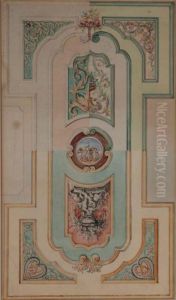Johannes Rienksz. Jelgerhuis Paintings
Johannes Rienksz. Jelgerhuis was a multifaceted Dutch artist known for his contributions as a painter, actor, and art teacher, born in 1770 in Leeuwarden, Netherlands. His work spanned various disciplines, showcasing his versatility and deep engagement with the cultural currents of his time. Jelgerhuis is particularly remembered for his detailed and atmospheric cityscapes, as well as his insightful portrayals of characters from the Dutch theater scene, which made a significant impact on the artistic landscape of the Netherlands in the late 18th and early 19th centuries.
Jelgerhuis's journey into the arts began at a young age, influenced by the rich cultural environment of his hometown. He initially trained under local artists before moving to Amsterdam, where he further developed his skills and began to establish his reputation. His paintings often depicted scenes from everyday life, imbued with a sense of realism and emotional depth that resonated with viewers. As an actor, Jelgerhuis was equally adept, bringing a nuanced understanding of human emotion to his performances, which were celebrated for their expressiveness and authenticity.
Throughout his career, Jelgerhuis also dedicated himself to the education of future artists, imparting his knowledge and passion for art to his students. He was a respected figure in the art community, known for his commitment to advancing the arts in the Netherlands. Despite facing challenges, including the changing artistic tastes of the period and personal hardships, Jelgerhuis's contributions to Dutch art remained significant. His works continue to be appreciated for their technical skill and emotional depth, offering insights into the cultural and social landscape of his time.
Johannes Rienksz. Jelgerhuis passed away in 1836, leaving behind a legacy that has ensured his place in the annals of Dutch art history. His paintings are preserved in various museums and collections, serving as a testament to his skill and vision. Jelgerhuis's life and work reflect the vibrancy of Dutch culture during a period of transition and growth, marking him as a notable figure in the development of the country's artistic heritage.
